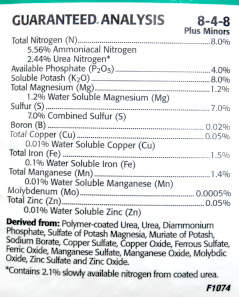A healthy lawn begins with healthy soil. Your lawn requires a good source of nutrients to maintain its color and vigorous growth. Be careful not to over-fertilize, as this can cause excess growth, excess thatch build-up, and excess work for YOU! Too little fertilizer can leave your lawn thin, yellow, and slow to recover from wear. To keep it looking its best, your lawn requires a balanced diet, with the right amount of food on a consistent schedule—just like people do.
Nutrition for New Sod Grass Installations in California– To get started right, your lawn will need a little bit of nitrogen, some phosphorus, and some potassium for good root growth. The fertilizer of choice should be similar to a 6-20-20 analysis (6% nitrogen, 20% phosphorus, 20% potassium) or a 15-15-15 (15% nitrogen, 15% phosphorus, 15% potassium). Apply the fertilizer right before the sod is installed, or immediately after the sod is installed.
If American Sod Farms is installing your lawn, you won't need to worry about this step. American Sod Farms fertilizes every yard we install with 15-15-15 right after we lay your sod!
If you want your new California sod to grow in a little bit faster, fertilize two weeks after planting with 15-15-15 (15% nitrogen, 15% phosphorus, 15% potassium). All the water that is put on the turf during the grow-in process moves some of the nutrients downward, out of the reach of the root system. Two weeks after planting is a good time to replenish the soil with a balanced fertilizer. Just like you, your turf requires a healthy diet.
Even after the sod is established, good diet will lead to healthy growth of your turf. Feed your lawn at least once a month with a balanced fertilizer, preferably with an analysis that is high in nitrogen, such as 16-8-4 or 21-7-14. Other popular analyses are 26-4-2, and 24-0-4.
If your lawn is growing too fast, fertilize every 8 weeks with a slow release fertilizer (with an analysis similar to 28-3-10 or 32-4-7). Slow release fertilizers spoon-feed the nutrients slowly into the soil so that your turf does not get too much nutrient at one time, and allows your turf to maintain good color while slowing down the growth.





